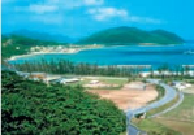Travel Reference
In-Depth Information
busy island like Okinawa, Iheya has it all. Although mountainous, it is, in fact, an agricultural
island. And there's some tourism, but not much.
What really stands out is the island's natural beauty, which is quite exceptional. It has sev-
eral excellent, almost deserted beaches; high vistas crossed by excellent hiking trails; Noho,
an attached, interesting smaller island to its south; and a particularly scenic northern cape
famous for being covered in Chinese fan palm trees. We'll start at the top and work our way
south and west.
Cape Dana (
田名岬
; Dana-misaki; also pronounced Tana-misaki), the northeastern tip
of Iheya, rather dramatically terminates with a 308-foot (94-meter)-high mountain capped
with a lighthouse. It's called Dana Kubayama (
田名のクバ山
; Dana-no Kubayama). here's
a small road that leads to the summit. It boasts two remarkable things, a spectacular view
that includes the ocean to the north and east and a good part of the island to the south and
west, and thousands and thousands of Chinese fan Areca palm trees known as
kuba
in local
Iheyan dialect. The trees are treasured as special places where gods descend. It's unusual to
find such a dense group of them and this holds special
kami
, thus it is an
utaki
sacred place
of worship. In fact, this species of palm is typical, but not common, in the Ryukyus, and for
whatever reason—a stray seed dropped by a passing bird or a seedling floated onshore that
took hold—they have flourished and congregate here. It's a unique natural sight.
Ferries arrive at Maedomari Port Marine Terminal.
Maedomari Port on Iheya's central east coast.


